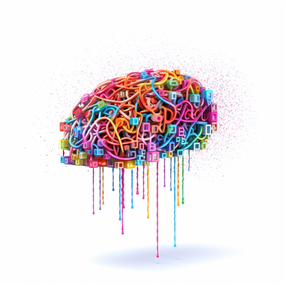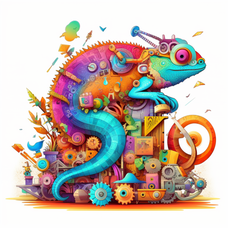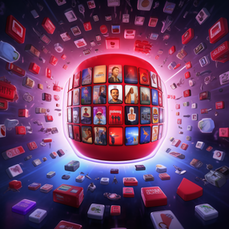Revolutionizing Marketing with AI Personalization Techniques
- Home
- Revolutionizing Marketing with AI Personalization Techniques
AI personalization techniques are revolutionizing the way businesses engage with their customers, delivering highly tailored experiences based on individual preferences and behaviour. As AI progresses, marketers need to keep up with the trend and learn how to make use of these sophisticated tools.
In this blog post, we'll explore cutting-edge developments in AI-powered personalization such as advancements in chatbot technology powered by GPT models and email marketing driven by machine learning algorithms. We will also delve into enhancing customer experience through human-AI collaboration, testing new processes via traditional growth team experimentation while streamlining interactions for a positive user experience.
Furthermore, we'll discuss adapting business strategies amidst SEO changes and diversifying online presence beyond search engine optimization. Lastly, you'll learn about reviving in-person events with AI's help and anticipating the decline of search traffic due to shifts in user behaviour driven by AI developments.
Table of Contents:
- AI Writing Tools and Their Limitations
- Personalization Through Artificial Intelligence
- Enhancing Customer Experience with Human-AI Collaboration
- Adapting Business Strategies Amidst SEO Changes
- Reviving In-Person Events with A.I.'s Help
- Anticipating the Decline of Search Traffic
- FAQs in Relation to Ai Personalization Techniques
- Conclusion
AI Writing Tools and Their Limitations
While AI writing tools have proven useful for functional content, they struggle to deliver high-quality results when differentiation is needed. As language models evolve and become more focused, marketers must be aware of their limitations in order not to rely solely on them for all content creation.
The rise of smaller, focused language models like Anthropic

In recent years, we've seen the emergence of Anthropic, a smaller and more focused language model that aims to address some of the limitations associated with larger AI writing tools such as OpenAI's GPT-3. While these advanced models can generate coherent text quickly, they often lack creativity or uniqueness due to their reliance on existing data sources.
This limitation becomes apparent when trying to create highly differentiated content that stands out from competitors. Smaller language models like Anthropic aim to bridge this gap by focusing on specific domains or industries while still leveraging powerful machine learning algorithms.
Balancing the use of AI-generated content with human creativity
To overcome the limitations posed by AI-generated content in marketing efforts, it's essential for businesses to strike a balance between using these tools and incorporating human creativity into their strategies. This approach ensures that your brand messaging remains unique while also benefiting from the efficiency offered by artificial intelligence technologies.
- Collaborative editing: One-way businesses can achieve this balance is through collaborative editing processes where both humans and machines contribute ideas during content development stages. For example, an AI tool might generate initial drafts based on input parameters provided by a marketer who then refines those drafts further before publication.
- Tailored outputs: Another strategy involves using AI-generated content as a starting point and then customizing it to better align with your brand voice or target audience. This approach can save time by automating repetitive tasks while still allowing for creative input from marketing professionals.
- Quality control: Finally, incorporating human oversight in the form of quality control checks ensures that all published content meets high standards of accuracy, relevance, and originality. By combining the strengths of both humans and machines, businesses can create compelling content that drives growth without sacrificing differentiation.
AI writing tools have their limitations, but smaller, more focused language models like Anthropic are emerging to address these issues. To get the most out of AI-generated content, businesses should balance its use with human creativity and quality control measures to ensure that their brand messaging remains unique and compelling.
AI writing tools have limitations when it comes to creating high-quality content that stands out from competitors. Smaller, more focused language models like Anthropic aim to bridge this gap by leveraging powerful machine learning algorithms while still allowing for human creativity and quality control measures. To get the most out of AI-generated content, businesses should strike a balance between using these tools and incorporating human input into their marketing strategies.
Personalization Through Artificial Intelligence
Leveraging AI technology enables businesses to provide personalized experiences across various touchpoints. From chatbots using GPT-3 or GPT-4 to email text personalization, these technologies help improve customer experience by delivering relevant information quickly and efficiently.
Advancements in Chatbot Technology Powered by GPT Models
The rise of advanced language models like GPT-3 has significantly improved the capabilities of chatbots. These AI-powered tools can now understand the context better and deliver more accurate responses, making them an invaluable asset for companies looking to enhance their customer service offerings. For example, a company might use a Watson Assistant-powered chatbot on their website that leverages GPT-3's natural language processing abilities to answer user queries with ease.
Email Marketing Personalization Driven by Artificial Intelligence
Beyond chatbots, AI-driven personalization techniques are also being applied in email marketing campaigns. By analyzing recipient data such as browsing history or past purchases, AI algorithms can generate tailored content recommendations that resonate with individual subscribers' interests and preferences. One popular tool for this purpose is HubSpot Email Marketing Software, which allows marketers to create highly targeted emails based on subscriber behaviour data collected over time.
 Data-driven segmentation: Using machine learning algorithms, businesses can segment their audience based on factors like demographics or online behaviour patterns - ensuring they send only the most relevant content possible.
Data-driven segmentation: Using machine learning algorithms, businesses can segment their audience based on factors like demographics or online behaviour patterns - ensuring they send only the most relevant content possible.- A/B testing optimization: With artificial intelligence at work, marketers can quickly identify the most effective subject lines or email layouts by analyzing user engagement metrics and applying these insights to future campaigns.
- Automated content generation: AI-powered tools like Persado can generate personalized copy for emails based on individual recipient profiles - making it easier than ever before to create compelling messages that resonate with your audience.
Incorporating AI-driven personalization techniques into your marketing strategy not only improves customer experience but also helps boost conversion rates. By delivering tailored content across various touchpoints, businesses can better engage their target audience and foster long-lasting relationships built on trust and relevance. Companies must remain competitive by utilizing cutting-edge technology such as AI for personalization.
Enhancing Customer Experience with Human-AI Collaboration
Implementing a "human-in-the-loop" approach allows companies to test unscalable solutions first before engineering the human out of the process. This strategy leads to improved customer satisfaction as they can complete tasks faster without needing direct assistance from support teams.
Testing New Processes Through Traditional Growth Team Experimentation
In order to optimize and enhance customer experience, businesses must continuously experiment with new processes that involve both AI technologies and human intervention. Growth team experimentation is an effective way for organizations to identify areas where AI can be successfully integrated into their existing systems while still maintaining a high level of personalization and empathy in interactions.
- Data analysis: By analyzing data gathered from user interactions, growth teams can pinpoint opportunities for improvement and determine which aspects of their service would benefit most from AI implementation.
- A/B testing: Companies should conduct A/B tests on different approaches involving varying levels of automation versus manual input, allowing them to measure the impact on customer satisfaction rates.
- User feedback: Collecting qualitative feedback directly from customers helps businesses understand how well their current strategies are working and whether there's room for further optimization through artificial intelligence integration.
Streamlining Customer Interactions While Maintaining a Positive Experience
The key challenge when implementing AI-driven solutions lies in striking the right balance between efficiency gains and preserving personalized experiences that foster long-term relationships with customers. To achieve this equilibrium, it's essential for businesses not only to focus on automating repetitive tasks but also to ensure that humans remain involved in more complex or sensitive issues.
For instance, IBM Watson Assistant is an AI-powered chatbot that can handle routine customer inquiries while seamlessly transferring more complicated cases to human agents. This approach enables businesses to sustain a superior service level without overworking their support staff.
- Maintain empathy: Ensure your AI solutions are designed with empathy in mind and avoid using overly robotic language or responses that may alienate customers.
- User-centric design: Develop your AI-driven tools based on user needs and preferences, incorporating feedback from real customers during the development process.
- Ongoing monitoring: Continuously monitor the performance of your AI systems, making adjustments as needed to optimize results and ensure they continue meeting customer expectations over time.
Incorporating a "human-in-the-loop" strategy when integrating artificial intelligence into business processes not only enhances efficiency but also fosters stronger connections between companies and their clientele. By focusing on continuous experimentation, maintaining empathetic interactions, and designing user-centric solutions, businesses can successfully leverage both human expertise and cutting-edge technology for improved customer experiences.
Adapting Business Strategies Amidst SEO Changes

As the digital realm progresses, companies must adjust their strategies to stay up-to-date with modifications in search engine algorithms. Google's BERT update, for example, has significantly impacted traffic patterns and necessitates a shift in focus from traditional SEO tactics. In this section, we will explore alternative methods like YouTube product demos and community events that can help your company not only survive but thrive during these transitions.
Diversifying Online Presence Beyond Search Engine Optimization (SEO)
To stay ahead of the curve amidst ongoing algorithm updates, it is crucial to diversify your online presence beyond just focusing on SEO. Consider expanding into other channels such as social media platforms or content-sharing sites where you can showcase your products and services more effectively. For instance:
- Email marketing campaigns: Reach out directly to customers by crafting personalized emails that highlight new offerings or promotions.
- Social media advertising: Utilize platforms like Facebook or Instagram ads to target specific demographics with tailored messages.
- Influencer partnerships: Collaborate with influencers within your industry who have an established audience base interested in what you offer.
Embracing Video Marketing Through YouTube Channels Showcasing Products and Services

A powerful way to engage potential customers is through video marketing via platforms like YouTube. By creating high-quality videos showcasing your products or services, you provide users with valuable information while also building brand awareness. Some tips for successful video marketing include:
- Create engaging content: Ensure that your videos are informative, entertaining, and visually appealing to keep viewers interested.
- Optimize video titles and descriptions: Use relevant keywords in your video titles and descriptions to help users find your content more easily.
- Include calls-to-action (CTAs): Encourage viewers to take action by including CTAs within the video or description that direct them towards purchasing a product or signing up for a newsletter.
YouTube marketing can be an effective way of reaching new audiences while also providing valuable content that sets you apart from competitors. As search traffic patterns continue changing due to algorithm updates like BERT, it is essential for businesses to adapt their strategies accordingly by exploring alternative channels such as YouTube product demos or community events alongside traditional SEO tactics.
Leveraging Community Events for Brand Exposure
In addition to digital marketing efforts, consider hosting or participating in community events as another avenue for brand exposure. At these gatherings, your business can make direct contact with potential customers who may not have found you through digital marketing alone. To make the most out of these events:
- Select relevant venues: Choose event locations where attendees are likely already interested in what you offer - industry conferences, trade shows, local meetups etc.
- Promote effectively: Utilize social media platforms and email campaigns leading up to the event date so people know when and where they can connect with you in person.
- Create memorable experiences: Provide engaging activities at your booth or during presentations that leave lasting impressions on attendees' minds long after the event has ended.
By adapting business strategies amidst SEO changes and diversifying online presence beyond just search engine optimization, companies can better position themselves for success as user behavior continues evolving due to advancements in AI technology.
Reviving In-Person Events with A.I.'s Help

As we move towards 2023, AI is expected to play a significant role in bringing back in-person events, especially community-based gatherings. This technology will help streamline event organization and management while also making it easier for companies to scale up their brand advertising efforts. Let's explore how artificial intelligence can power the resurgence of community-focused events and enable efficient planning and execution.
The Resurgence of Community-Focused Events Powered by Artificial Intelligence
In recent years, there has been a growing interest in local, community-driven events as people seek more authentic experiences and connections. AI-enabled tools like NLP and ML algorithms are being utilized to help event organizers gain insight into what their attendees desire, allowing them to create more tailored experiences that will have a greater impact on the audience.
For example, AI-powered tools such as Cvent or SplashThat can analyze user data from registration forms or social media interactions to identify trends or common interests among attendees. This information enables organizers to curate engaging activities that foster meaningful connections between participants.
Leveraging AI-Driven Tools for Efficient Event Planning and Execution
Beyond personalization capabilities, artificial intelligence offers numerous benefits when it comes to streamlining event planning processes. From automating mundane tasks like scheduling meetings or sending reminders to optimizing resource allocation based on real-time insights - these innovations save time while ensuring seamless coordination among team members.
- Venue selection: By analyzing historical data on venue performance, AI algorithms can recommend the most suitable locations for specific events. This helps organizers make informed decisions and avoid potential pitfalls associated with poor venue choices.
- Attendee management: Tools like Eventbrite leverage machine learning to predict attendance numbers, allowing planners to optimize event capacity and resources accordingly. Additionally, facial recognition technology can streamline check-in processes while enhancing security measures at large-scale gatherings.
- Real-time feedback: AI-driven sentiment analysis tools enable organizers to gauge attendee satisfaction during an event by monitoring social media posts or survey responses. This allows them to address any issues promptly and improve overall experience quality.
Incorporating artificial intelligence into event planning not only enhances personalization but also simplifies logistics and improves efficiency - all crucial factors in reviving in-person events as we move forward. By embracing these innovative technologies, businesses can create memorable experiences that foster lasting connections within their communities while scaling up brand advertising efforts effectively.
Artificial intelligence (AI) is expected to play a significant role in bringing back community-based gatherings and events, with its ability to streamline event organization and management. AI-powered tools can analyze user data from registration forms or social media interactions to identify trends among attendees, enabling organizers to curate engaging activities that foster meaningful connections between participants while simplifying logistics and improving efficiency.
Anticipating the Decline of Search Traffic
As advancements in AI technology continue to reshape user behaviour, search traffic is projected to decline starting Q4 2023. Businesses must prepare themselves by exploring alternative marketing channels like YouTube product demos or investing more heavily in brand advertising. Companies that adapt early on will be better positioned for success as they navigate these changes.
Preparing for Changes in User Behavior Driven by AI Developments
To stay ahead of the curve, it's crucial for businesses to understand how AI developments are impacting user behaviour and preferences. For example, voice search and virtual assistants are becoming increasingly popular due to their convenience and efficiency. As a result, traditional text-based searches may see a decline in usage over time.
- Voice Search: With devices like Amazon Echo and Google Home gaining popularity, optimizing content for voice search is essential. This includes focusing on long-tail keywords and natural language queries rather than short phrases.
- Virtual Assistants: Siri, Alexa, Cortana - these virtual assistants are changing the way users interact with online content. Ensuring your website can be easily navigated through conversational interfaces will help maintain visibility amidst shifting trends.
In addition to adapting SEO strategies based on new technologies, businesses should also explore other digital marketing avenues beyond traditional search engine optimization (SEO).
Exploring Alternative Marketing Strategies Beyond Traditional SEO
Diversifying your company's online presence can help mitigate potential losses from declining search traffic while opening up new opportunities for growth:
- Email Marketing Personalization: Leverage AI-powered tools such as HubSpot or MailChimp to deliver personalized, relevant content directly to your audience's inbox.
- Social Media Advertising: Take advantage of the highly targeted advertising options on platforms like Facebook, Instagram, and LinkedIn. These channels allow you to reach specific demographics based on interests, location, and more.
- Video Marketing: Create engaging video content for platforms such as YouTube and Vimeo that showcase your products or services in action. This can help boost brand awareness while providing valuable information to potential customers.
- Influencer Partnerships: Collaborate with influencers within your industry who have a strong online presence. Their endorsement can drive traffic and increase credibility for your brand.
The key takeaway is that businesses must be proactive in anticipating changes driven by AI advancements - not only adapting their SEO strategies but also exploring alternative marketing channels beyond traditional search engines. By doing so, companies will be better positioned for success amidst the evolving digital landscape.
FAQs in Relation to Ai Personalization Techniques
How is AI used for personalization?
AI is used for personalization by analyzing large amounts of data to identify patterns, preferences, and behaviours. This enables businesses to tailor content, recommendations, and experiences based on individual user profiles. Techniques include machine learning, natural language processing (NLP), and predictive analytics.
Is personalization an AI?
Personalization is not an AI itself but a process that can be powered by artificial intelligence technologies. By leveraging AI algorithms and models like machine learning or NLP, companies can create personalized experiences tailored to each customer's needs, interests, and preferences.
How does AI personalize the customer experience?
AI personalizes the customer experience through various methods such as targeted product recommendations based on browsing history or purchase behaviour; dynamic pricing according to demand patterns; customized email campaigns using segmentation techniques; chatbots providing real-time assistance with context-aware responses; and sentiment analysis in social media interactions.
How AI helps in giving you a personalized experience online?
AI enhances your online personalized experience by delivering relevant content suggestions based on your interests or past actions; optimizing website layouts for better usability depending on device type or screen size; creating adaptive user interfaces considering cognitive abilities or accessibility requirements; predicting search queries for faster results retrieval (autocomplete); and tailoring ads targeting specific demographics while respecting privacy concerns.
Conclusion
AI Personalization Techniques are rapidly evolving, and companies must adapt to remain competitive. From AI writing tools to chatbot technology and human-AI collaboration, businesses can leverage these advancements for enhanced customer experiences and effective marketing strategies.
However, it's crucial to balance the use of AI-generated content with human creativity while anticipating changes in user behaviour driven by AI developments. Diversifying online presence beyond SEO and leveraging video marketing can also help companies prepare for future changes.
If you're looking for guidance on how to implement these techniques into your business strategy, contact Whitehat Agency. Our team of experts can help you navigate the complex world of AI personalization techniques and drive growth for your company.


